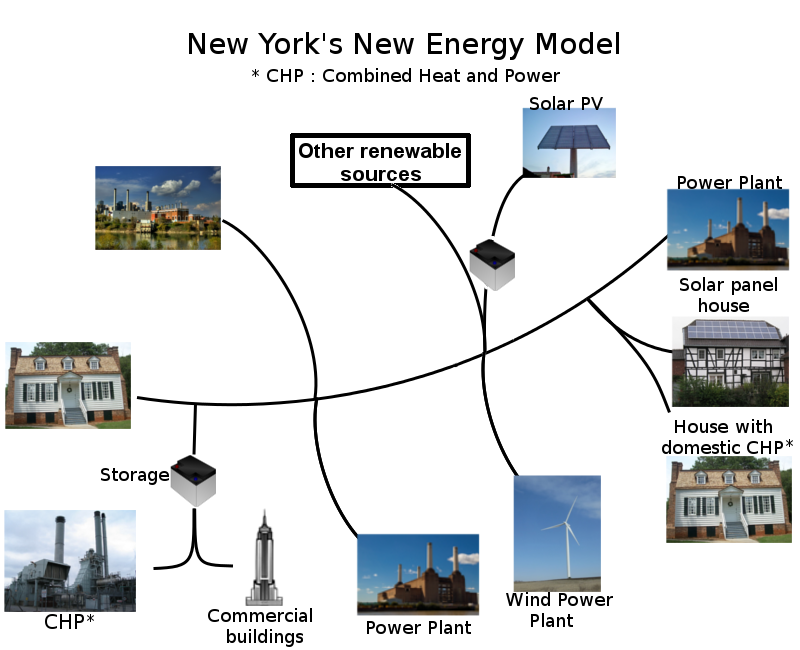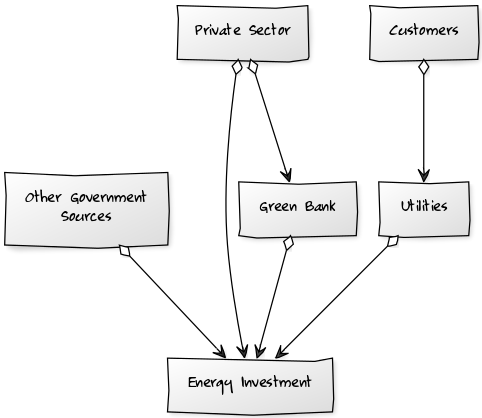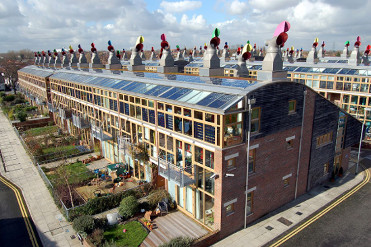New York State's Electricity Grid Reform
New York’s electricity infrastructure is outdated, unreliable, and inefficient, leading to high electricity prices. Recently passed 2014 Reforming the Energy Vision (REV) legislation seeks to completely overhaul the state's electricity market.
This article is a guide to how the electricity system will change in New York, and what effects this will have for consumers.
| Summary |
|---|
Reforming the Energy Legislation: Time for a Change
The goal of new Reforming the Energy Vision (REV) legislation is to make electricity in the state of New York:
- More customer-oriented and more interactive
- More efficient and effective - Lower prices
- More sustainable
- More responsive to demand changes, both with price and with supply
- Help keep customers be more responsive to price changes
Current Problems with New York's Electricity Grid
Centralized Delivery
New York state's current electricity system, like most of the US, is modeled around large producers of energy, who transmit energy long-distances at high voltages, before lowering the voltage and distributing it again to consumers’ homes. This model was developed based on limited technology, during a time when electricity demand was stable.
- The problems with this model include:
- Electricity lost over long delivery distances
- Storage of electricity difficult and expensive
- Demand no longer stable - high unused system capacity
In traditional electricity systems like New York’s, capacity is based on highest demand levels. In order to meet peak demand in the summer, when New Yorkers use more electricity to power air conditioners, the electricity grid is left with high unused capacity during other seasons, when electricity consumption is lower.
Below is a depiction of the difference between peak and average demand in New York. If they were the same, the ratio would be 1:1.
New York's electricity delivery system is not well-equipped for peaks and troughs in demand. Since there is little to no communication between consumers and producers, changes in demand are not always accommodated in time.
Fuel and Resource Diversity
New York currently relies heavily on natural gas to produce electricity. Because the price of gas is volatile, electricity is in turn subject to all fluctuations in the price of gas. A diverse energy portfolio would protect New Yorkers from electricity price shocks.
The below graph depicts New York's current lack of fuel diversity for electricity production. Renewable energy production is low.
Climate Change & Natural Disasters
After the havoc wreaked from Hurricane Sandy, New York state wants to decentralize the system and protect it against future natural disasters. For instance, if one part of the system has an outage, it knocks out the entire interconnected grid. With a decentralized electricity system, outages stay local. In addition, the current system is not environmentally-friendly, contributing to climate change and more extreme weather events.
New York's Energy Plan: Distributed Energy Resources (DER)
In order to modernize and strengthen New York's electricity grid, a key plan is to bring energy closer to consumers. Distributed Energy Resources (DER) are decentralized technologies, usually operating on renewable energy, that either generate or store electricity much closer to their consumers.
DERs are praised for their energy efficiency. Traditional electricity sources are generally located far from consumers, and much electricity is lost during a two-step delivery process. This problem is nearly eliminated with DER systems, which have much shorter distances to travel, and only one step in delivery. Though their generating capacity is smaller than centralized systems, DER systems operate with a larger number of widespread generation stations to make up the difference.

Electricity Storage
In order to avoid other opportunities for electricity waste, new Distributed Electricity Resource (DER) technologies allow for effective electricity storage. Generators can produce electricity during times of low demand, and store it for later when demand rises again. Also if electricity is delivered to a customer’s home in excess of what the customer needs, they can send it back to the DER for storage, since New York’s DERs will also feature two-way electricity flow (into and out of homes, for example). These storage systems greatly reduce stress on the generation and delivery system during times of high demand.
If just 100 hours of highest peak demand were normalized, savings would be between $1.2 billion and $1.7 billion per year. (NYPSC)
Distributed Energy Resources (DER) Technology
So what are some of the types of DERs that may be coming to New York, and how will they work? Government-funded New York State Energy Research and Development Authority (NYSERDA) and utilities will work within Research & Development to develop an innovative electricity grid and market that can work better for New York.
- Some renewable energy sources used by DERs:
- Wind Power
- Solar Power
- Biomass, or the use of organic materials (alive or recently so) to generate power. For example, leftover materials from logging can be used to generate electricity.
- Biogas, or a combination of gases from decomposing materials is used to produce energy. For example, recycling can be used.
Combined Heat and Power
Combined Heat and Power (CHP) plants are able to generate electricity and heat at the same time. The excess energy created during the production of electricity normally goes to waste, but CHPs are able to store this excess energy as heat for home use. They can also operate as a type of local DER unit, insulating consumers from nearby outages.
During Hurricane Sandy,
Co-op City in Baychester, Bronx never lost power because it had its own Combined Heat and Power plant.
New York state will expand CHP as another source of renewable energy.
Online Accessibility to Customers
After releasing a “Straw Proposal” for Reforming the Energy Vision (REV) on August 22, 2014, NYPSC envisioned utilities working together to design “web-based tools” for customers to choose and purchase “DER and other energy-related value-added services” themselves, keeping customers in the loop as active decision-makers.
Microgrids and Smart Grids
In order to improve communication among and between different levels of the consumption process - producers, distribution utilities, consumers, and wholesale electricity markets - New York is looking to improve the integration of technology into electricity consumption with what are called Smart Grids.
DERs are normally connected to each other through microgrids, which have to initially be connected back to the main system of power generation. Microgrids can eventually be disconnected from the main source of power, making them more impervious to changes in demand and system failures on a large scale.
Smart Grids take these gains one step further: By using modern communications technology, they integrate information between all levels of energy production and consumption for benefits including:
- Communication with consumers when demand is high - Examples include an appliance monitor which notifies customers during times of high demand, so they can decide whether to shift their use
- Improving system reliability through sensors and monitoring of system failures
- Two-way flows of energy - Consumers may even be able to sell back excess electricity in their homes
- More intelligently anticipate spikes in demand
And more.
How will all these changes be managed in New York?
New Oversight: The Distributed System Platform Provider (DSPP)
New York state has called for the creation of a Distributed System Platform Provider (DSPP) which will oversee the majority of elements related to the new REV plan’s implementation. This includes interfacing between all electricity market stakeholders, including the wholesale electricity market, as regulated by the New York Independent System Operator (NYISO), generation and distribution utilities, and consumers. DSPP will also ensure that communication is efficient and transparent, helping consumers easily respond to changes in price and demand.
DSPP will oversee the development of New York’s Distributed Energy Resource (DER) system, in addition to making sure that it becomes a primary source of electricity for New Yorkers, and a price sensitive one.
Based on their existing expertise and insight, distribution utilities will serve as DSPPs. According to REV, an independent body would be preferable, but too much redundancy is involved in employing a separate body to do what distribution utilities are already well-equipped to do.
Better Data Collection and Utility Responsibility
In the follow up “Straw Proposal,” the NYPSC asked utilities to produce an “Efficiency Transition Implementation Plan”, which must describe how they will “optimize and monitor their energy efficiency portfolio in support of improved system efficiency and operation.” This promotes transparency, and also requires utilities to be accountable for changes.
How to pay for these changes
There is of course, the issue of making all these costly changes attractive to utility companies. According to Audrey Zibelman, chairwoman of the NYPSC, "What we're looking at is actually a model that gives the utilities incentives to create greater system efficiencies so that, if they actually reduce demand or promote energy efficiency, they can make money, essentially." Which means, utility companies will be rewarded for smart investment now with payoff later.
"What we're looking at is actually a model that gives the utilities incentives to create greater system efficiencies so that, if they actually reduce demand or promote energy efficiency, they can make money, essentially." - Audrey Zibelman
The DER system will help to keep capital costs down, and will eventually earn money for utilities. Nevertheless, new modern, renewable energy systems still need to be built, and it is estimated that investment will need to be around $30 billion over the next 10 years.
Green Bank
New York’s Green Bank was developed by New York State Energy Research and Development Authority (NYSERDA) to raise capital for green electricity innovation. In addition to getting funds from the private sector, Green Bank makes full use of green energy capital markets to leverage funding. The goal for the bank is to become financially independent from the government, and motivate complementary financing from other private sector sources.
Ratepayer Contributions
A stated objective of REV legislation, consumers will help cover the funding gap between investments, loans, and government financing for New York’s energy overhaul. Consumer contributions are regularly used to fund utility improvements. In order to ensure utilities are making good use of customers’ contributions during periods of high infrastructural investment, New York could require utilities to meet “performance” standards, or in other words, prove that key improvements are being made in areas like energy efficiency and lower retail prices.
According to August 2014 proposals, retail customers may also be able to pay to join in with DER and other technology, based on the savings and efficiency promised with new investments.
Paying for New York's Electricity Reform

Implementation Begins
The New York Public Service Commission has asked for utilities to deliver proposals as soon as possible. There are already some who have begun to take part.
ConEdison
According to Stuart Nachmias, vice president of energy policy at ConEdison, "This really sets the platform for how the future of the electric system can work with more resources and more options for our customers." ConEdison has already begun building DER systems in Brooklyn and Queens, and hopes this investment will help delay the need for a new power plant.
ConEdison is also supporting individuals and businesses who want to purchase their own distributed generation (DG) systems and plug them into the ConEdison grid.
Central Hudson
In July 2014, Central Hudson filed a new plan costing $40 million to do things including update infrastructure, develop “community solar projects,” and create “regional subscription-based microgrids for business parks, campuses, urban areas or even neighborhoods.”

An example of a Solar Community Project in Sutton, London, UK
In the proposal, Central Hudson stated that electricity bills would go up about $4.78 per month to finance the plan, with average bills standing at $107.87 per month in 2013.
Critical Reception
The REV proposal has in general been well received by organizations including Tendril, and Greentech Media.
The Good
According to Marie Bahl McKenna at Tendril, a software firm which delivers personalized energy plans, “I believe [the Straw Proposal] is largely good… I hope this effort started by New York State becomes a template that we can stand upon to spur this necessary change.”
Critiques
There are however, some critiques. Adrian Tuck, CEO of Tendril, asserts that information will need to be simple. Says Tuck, "Consumers, whilst they're not [averse] to doing these things, by and large aren't going to spend a huge amount of time thinking about them." Organizations like AARP also worry about ease of adoption for older and low-income consumers, in addition to concerns about extra costs.
Complexities
Paul Alvarez, president of Wired Group, a utility consultancy firm, thinks implementation will be complex. “How much do utilities get paid for doing this? How do you measure that, and translate those measurements into increased profits, while making sure you’re not making power too expensive? You don’t want to do things that reduce [utilities'] capacity to make money when they’re investing in all these projects. On the other hand, you don’t want them to make any windfall profits, and you want to allow third-party players to compete,” he says.